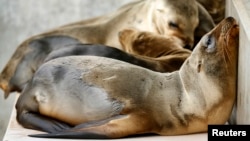The strandings of a record number of sea lion pups along the California coast this year are linked to a puzzling weather pattern that has warmed their Pacific Ocean habitat and most likely has affected fish populations they rely on for food, federal scientists said Wednesday.
Marine mammal centers in California have treated some 940 stranded sea lions, mostly pups, so far this year, said Justin Viezbicke, West Coast stranding coordinator for the U.S. National Oceanic and Atmospheric Administration.
That is well above the 240 strandings typically seen through April, and scientists suspect the emaciated pups are prematurely leaving Southern California sea lion rookeries to seek food on their own after their mothers failed to return swiftly from hunting trips to nurse.
"These little pups, so desperate and so thin, are leaving the rookeries long before they're capable of hunting effectively,'' said Shawn Johnson, director of veterinary science at the Marine Mammal Center in Sausalito, which has treated 220 stranded animals. "It's alarming because we haven't seen this number of stranded pups this early in 40 years.''
The strandings are unusual because the pups, born last June, aren't supposed to be completely weaned until May.
Satellite data show sea lion mothers are foraging in traditional hunting grounds, but most likely are spending longer periods away, said Sharon Melin, a biologist with NOAA's National Marine Mammal Laboratory in Seattle.
Fish populations are probably being disrupted by a layer of ocean water, about 100 meters (330 feet) deep, that is 2 to 5 degrees warmer than usual this time of year along the Pacific Coast from Baja to Alaska's Aleutian Islands, NOAA climatologist Nate Mantua said.
The change was caused by a weather pattern involving weak northern and strong southern winds that are creating warmer-than-normal conditions.
It's unclear how many stranded animals will die among the 300,000-strong sea lion population. In 2013, 70 percent of nursing pups perished in what NOAA declared an "unusual mortality event'' linked to strandings.
Melin said pups checked on San Miquel Island this month were 44 percent below average weight at 7 months old, marking the lowest growth rate since scientists began recording such measurements in the 1990s.
Most of the stranded pups have been recovered in Southern California, but the pups also swim or are carried further north, and may eventually turn up in Washington state and Oregon, Johnson said.
"We're braced for more,'' Johnson said.
